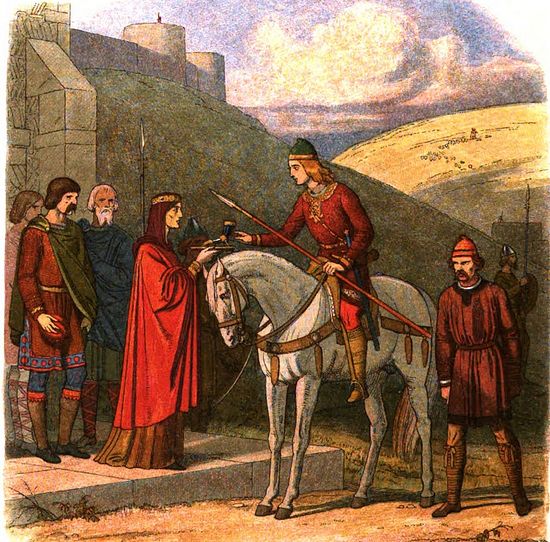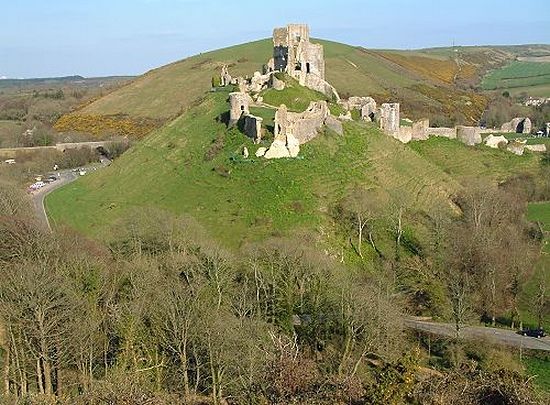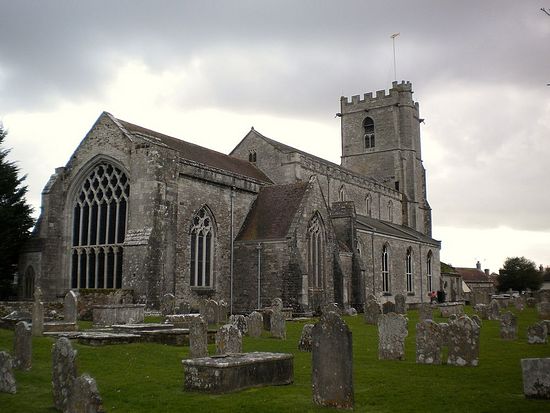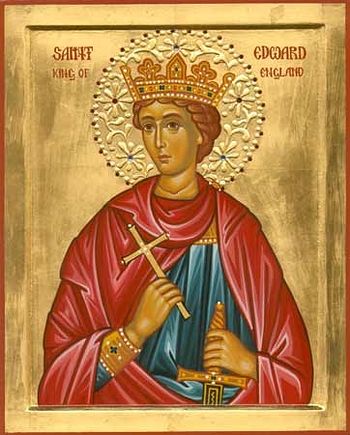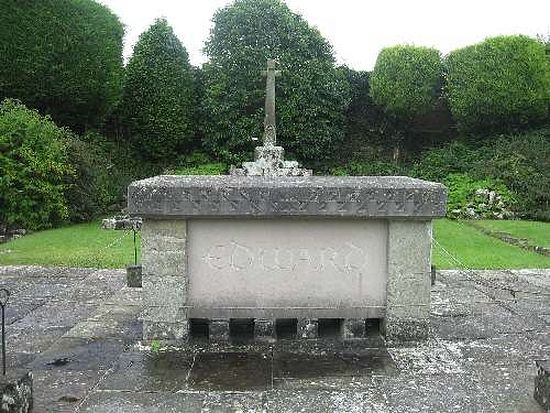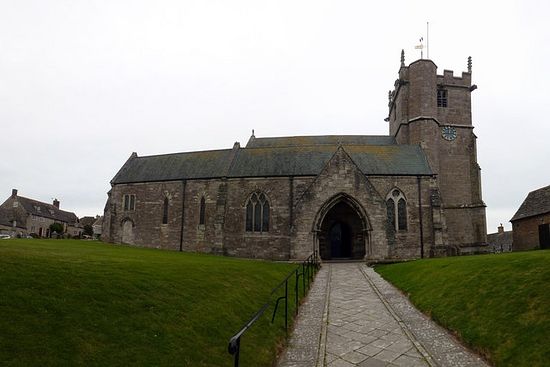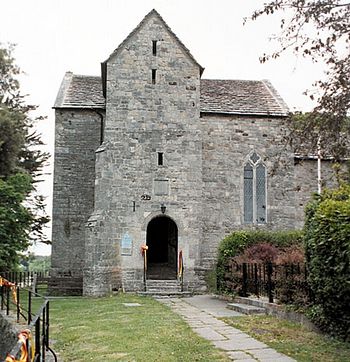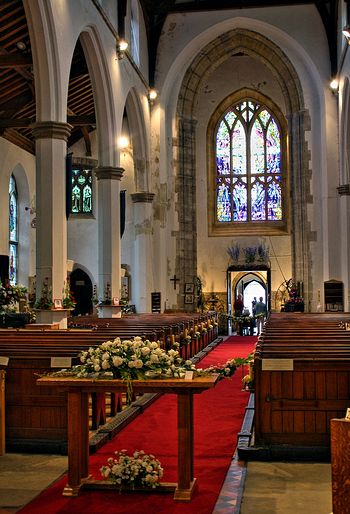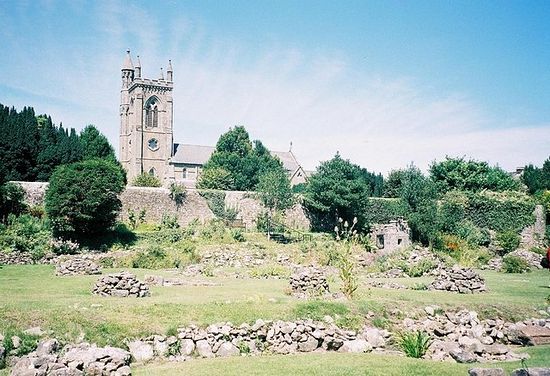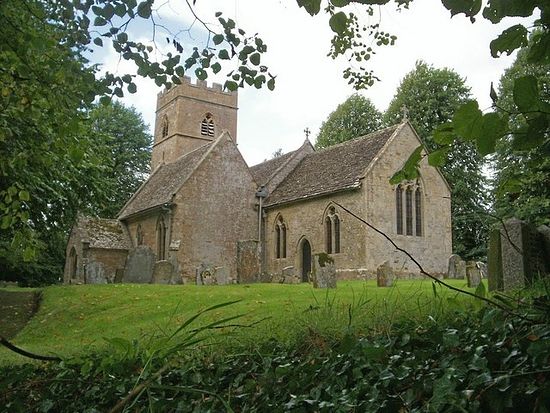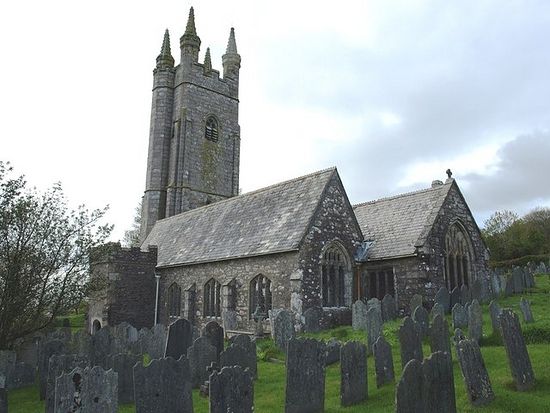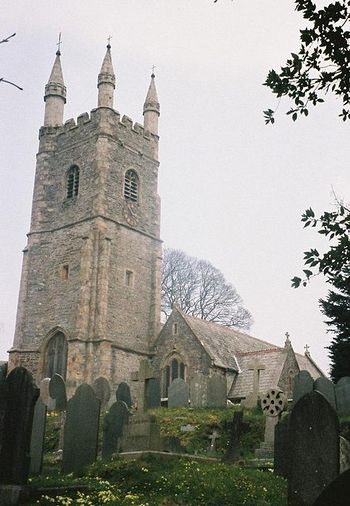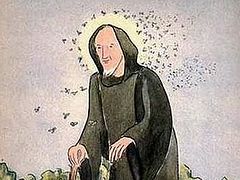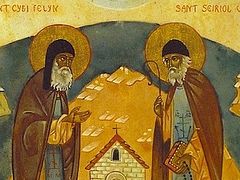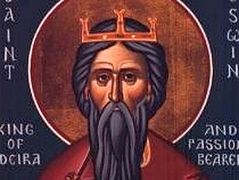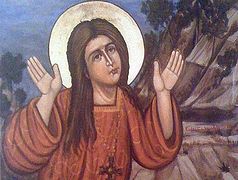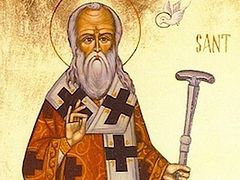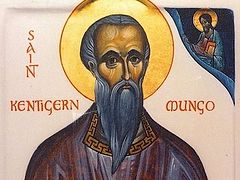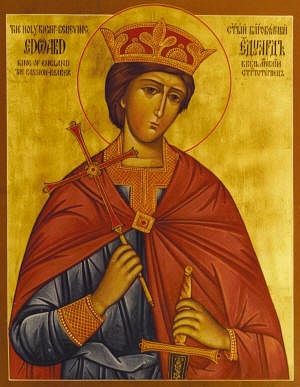
St. Edward, one of the most venerated English saints, was the son of the Holy Right-Believing Edgar the Peaceful, King of England, and Queen Ethelfleda who died soon after his birth. According to different sources St. Edward was born either in 959 or in 962/963.
The reign of King Edgar was marked by a great revival of monasticism, Church life and piety among the English people and he wholeheartedly supported the three great episcopal restorers of the English Church after the ninth century Danish invasions: Dunstan of Canterbury (who baptized Edward), Oswald of Worcester, and Ethelwold of Winchester. According to tradition, some time before St. Edward’s birth St. Edgar had an unusual dream, which his wise and saintly mother Elgiva (St. Edward’s grandmother), formerly Queen and then Abbess of Shaftesbury, explained thus: following St. Edgar’s repose the English Church would be attacked, the supporters of his (Edgar’s) younger son would murder his elder son, the former then would reign on earth while the latter would reign in Heaven. These prophetic words eventually came true. St. Edward’s younger brother was Ethelred (“Ethelred the Unready”, 968-1016) who was born from his father’s second marriage.
St. Edward ascended the English throne in 975 at the age of only thirteen (or sixteen) after the sudden death of his father St. Edgar aged only thirty-two. According to one of the sources of that time, St. Edward was a young man of piety, exemplary behavior, a genuine Orthodox Christian who led a devout and God-fearing life. As his father St. Edgar—especially in the second half of his life—young Edward loved God and the Church above all things. He was a benefactor of the needy, a refuge for the pious, defender of the faith of Christ, and filled with many virtues. Sts. Dunstan of Canterbury and Oswald of Worcester anointed him as King at Kingston upon Thames. On becoming King, St. Edward with great enthusiasm continued the labors of his father to revive and strengthen the Church and monastic life in the country; many new monasteries were opened or restored all over England during his short reign. Prayer and Christian piety were the basic things that St. Edward saw at the core of a true kingdom.
Unfortunately, all this was not to last long—soon the whole of England was stricken with a terrible famine. And at the same time disturbances began in the country that added to this tragedy: some aristocrats were extremely unpleasant with St. Edward for endowing monasteries with lands and estates. These nobles decided to acquire these lands at all costs for themselves. Some of them in their fury even attacked a number of monasteries and temporarily drove out monks and nuns from them and replaced them with married clergy. The noblemen wished to depose the godly and resolute ruler Edward and instead enthrone his younger brother, the pliable Ethelred. The Archpastor Dunstan of Canterbury, one of the greatest prophets and visionaries of the English Church, who stood at the head of the English Church in the second half of the tenth century for nearly thirty years, did all his best to defend St. Edward and support him in his activities; in fact, a majority of the aristocrats supported him as well. However, several wicked nobles, apparently together with St. Edward’s widowed stepmother Elfrida, thus conceived a plan to murder the innocent king.
And on March 18, 978 (according to another version, 979) St. Edward was treacherously slain. This happened in the following way. On that day the young Edward was hunting in the forest not far from the town of Wareham in the county of Dorset in south-west England. He decided to pay a visit to his brother Ethelred who was being brought up at his mother’s in Corfe among the Purbeck hills (a ridge of chalk downs) nearby. As Edward approached Corfe on horseback, Elfrida at once came up to him and with a sham greeting offered him drink. As soon as Edward took the goblet, one of the courtiers suddenly thrust a knife into him. The King fell out of his saddle, one of his feet stuck in the stirrup, and the horse dragged the wounded King, nobody helping him, until his dead body finally fell into the spring at the foot of the hill where Corfe Castle stands today. (It was said that water of this spring healed many people from eye diseases).
On the orders of Elfrida the body of the martyred king was thrown into a tiny dilapidated hut very close to the site of his martyrdom. A certain woman lived in this house who was blind from birth. On the following night she felt as if an unearthly light had entirely filled her cottage and she was healed from blindness at once. Under the shabby clothes with which the murderers had covered the saint’s body the woman found the King’s holy relics. Next morning many people in the vicinity learned about the miracle, including the Queen who then ordered her servants to bury Edward’s relics in a boggy area near Wareham and to forget about the King forever.
This is approximately what “the Anglo-Saxon Chronicle” wrote on St. Edward late in the tenth century: “Since the Angles came to the island of Britain they have not committed a more terrible crime than this one. People killed him, but the Lord glorified him: in lifetime an earthly king, and after death—a Heavenly saint. The murderers wiped the memory of him from the face of the earth, but the Heavenly Father made him holy both in Paradise and on Earth. Those who did not kneel before him when he was alive now humbly venerate his precious relics. Now we see that the wisdom of men, guile and plans of this world are nothing in comparison with the providence of God.” And God vouchsafed the people to see with what glory St. Edward was rewarded.
In about 980, above the exact place of burial of the martyred King, a bright pillar of light began to appear. Seeing this, the people of Wareham found St. Edward’s grave and dug up his relics, which turned out to be absolutely intact. On the same day a spring of pure water gushed forth at that site, and a holy well with curative powers existed there for many centuries. It was decided to bury St. Edward’s body in the local church dedicated to the Virgin Mary. This lovely church stands in Wareham to this day attracting pilgrims. The fame and veneration of the martyred King increased very speedily among the faithful, priests, monks and bishops. More and more wonderful miracles occurred at his grave.
A year passed, and thus, in 981 it was decided to uncover the remains of St. Edward and with a solemn procession translate them to the monastery in Shaftesbury in Dorset, not far away. This monastery had been founded in 888 by the saintly King Alfred the Great (St. Edward’s ancestor) and his holy daughter St. Ethelgiva. Among those present at the ceremony of the uncovering of his relics were Archbishop Dunstan, many abbots and abbesses, Holy Abbess Edith of Wilton in Wiltshire—St. Edward’s sister—as well as a multitude of Dorset people. Having opened the King’s grave and seeing his fragrant and incorrupt relics, everybody thanked the Almighty and carried them in procession to the convent of Shaftesbury, for that was the will of God.
This convent, then dedicated to the Mother of God was later rededicated to the Mother of God and St. Edward the Martyr. The king’s relics were buried in the altar of the monastic church. According to tradition, two paralytics were healed when the saint’s relics were being carried from Wareham to Shaftesbury. Over the next 20 years a great many other miracles occurred at his relics. Thus, once he appeared in a dream to a woman who was lame and could hardly walk. He told her to go to the Shaftesbury convent, setting all her hopes on the Lord. With great difficulty and great faith the lady came to the convent and was completely healed on the same day.
After the martyrdom of St. Edward, the next King of England was the above-mentioned Ethelred, who had been a child when his elder brother was slain. Ethelred deeply loved and venerated his martyred innocent brother for the rest of his life. It was recorded that when Dunstan crowned Ethelred King he predicted to him that for the sin of regicide England would be punished and eventually invaded. His prophecy was fulfilled after his (St. Dunstan’s) death in 988: the Danes resumed their devastating raids on England and eventually martyred Archbishop Alphege of Canterbury in 1012, and in 1066 England was invaded again by the Northmen—the Normans. According to some sources, St. Edward’s stepmother Elfrida, possibly responsible for the murder of the innocent king, who was also very beautiful, afterwards repented and ended her life in a convent, though there is not sufficient evidence to confirm this.
In the year 1001 the grave of St. Edward in Shaftesbury miraculously began to rise from the ground. In this way the Lord revealed His will: the relics of such a glorious saint were to be translated to a more honorable site. Soon Edward himself appeared to one monk and asked him to go and tell the Abbess of Shaftesbury that the saint’s relics should be placed in a shrine. This idea was approved by all, including King Ethelred. The grave of the king was again opened and everybody felt such an indescribable sweet fragrance from his incorrupt body that they could not understand whether they were on Earth or in Paradise. The relics of the holy king were then translated into a beautiful and richly adorned shrine.
In 1008, St. Edward was officially canonized by St. Alphege of Canterbury. Since that time he has been greatly venerated as a martyr and passion-bearer; for he knew that he might be slain by his opponents, but for the love of Christ he did not oppose them, relying fully on the will of God. The veneration of St. Edward, who became known as Edward the Martyr, spread far and wide and with time he was venerated all over England and even abroad. Five ancient churches were dedicated to him. Small portions of his relics from the eleventh century were translated to Abingdon in Oxfordshire, Leominster in Herefordshire, Salisbury in Wiltshire, Glastonbury in Somerset and Durham in County Durham. Throughout the centuries countless miracles of healing have occurred through St. Edward’s intercession, especially healings from eye and leg diseases.
For example, under King Edward the Confessor in the mid-eleventh century, a man from France with acute pain all over his body, who was specially transported to the saint’s shrine, and a blind boy as well as a leper were healed by St. Edward’s relics, along with many others. In medieval times Shaftesbury Abbey became the largest and wealthiest Benedictine convent in all England. And it was among the most important shrines of the country, attracting thousands of pilgrims to St. Edward’s and other saints’ relics. The town of Shaftesbury was for several centuries known as “Edwardstowe”—such was the veneration of the saint. Only under Henry VIII was the town again known as Shaftesbury. At the time of the Reformation, in about 1539, Shaftesbury Abbey, like many other monasteries, was dissolved and then destroyed, while the relics of St. Edward were hidden in the grounds of the convent to avoid desecration.
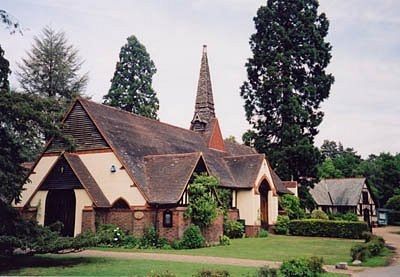 St. Edward's Orthodox Church in Brookwood, Surrey
St. Edward's Orthodox Church in Brookwood, Surrey It was said that until the early twentieth century one unique relic existed, namely a lung of St. Edward, but even that was destroyed by radical Protestants. However, in the twentieth century the Lord worked a miracle: in the early 1930s the saint’s relics (well-preserved bones) were again uncovered by an amateur archaeologist, J. Wilson-Claridge, among the ruins of Shaftesbury Abbey. A thorough expertise helped ascertain that these are the authentic relics of St. Edward the Martyr, King of England. St. Edward’s relics, by a miracle of God returned to England and to the faithful, were donated to the Orthodox Church of St. Edward the Martyr in Brookwood Cemetery near Woking in Surrey, not far from London. Originally this community was in the jurisdiction of the Russian Orthodox Church Outside Russia, but now it belongs to a small old calendarist Greek monastic brotherhood. It is visited by pilgrims from England and abroad. Significantly, there is modern (including written) evidence of miracles and healings occurring through his intercession.
Many churches are dedicated to St. Edward. In addition to the above-mentioned Brookwood church, the saint is also particularly venerated in all the sites closely connected with his martyrdom and his ancient medieval veneration in Dorset. All these places attract Orthodox and other Christian pilgrims, as well as tourists, as Dorset is noted for its beauty. St. Edward is remembered in the village of Corfe Castle, where extensive remains of the castle still survive. Notably, the local parish church is dedicated to St. Edward and it is believed to stand on the very site where the original blind woman’s dwelling, where his relics had been thrown by the order of Elfrida, used to stand many centuries ago. St. Edward’s well at Corfe associated with his martyrdom has existed for over 1000 years, and until the late twentieth century its water was prescribed for eye trouble and ague.
The next destination is the pretty town of Wareham which boasts of two early English churches, both extant. The first church is called St. Martins-on-the-Walls, dedicated to St. Martin of Tours —it was mostly built in the 1030s; the other one is St. Mary the Virgin’s Church which has a chapel dedicated to St. Edward. This is the very church in Wareham, mentioned before, where the King’s relics lay from 980 to 981. Some researchers say that this church still contains the coffin in which the saint’s body was interred 1035 years ago. Finally, this town has a Roman Catholic Church dedicated to St. Edward.
The small town of Shaftesbury is another Dorset destination associated with St. Edward. Today there are the ruins of the once magnificent Shaftesbury Abbey that housed the saint’s relics, and the abbey museum and gardens are situated just next to the abbey grounds. The town also has the Roman Catholic Church of the Most Holy Name and St. Edward the Martyr.
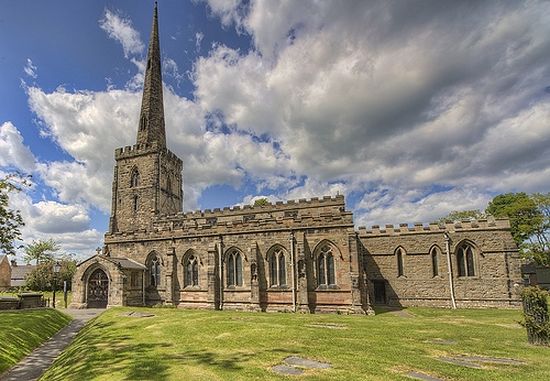 St. Edward's Church in Castle Donington, Leicestershire
St. Edward's Church in Castle Donington, Leicestershire
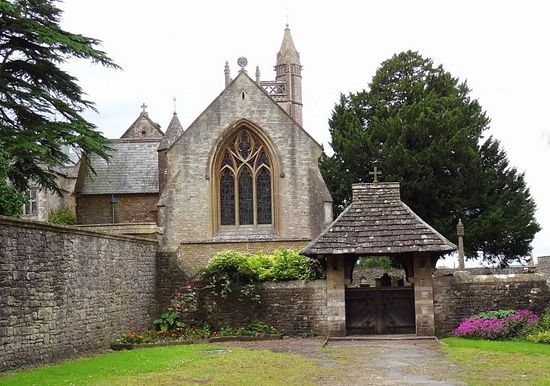 Church of St. Mary and St. Edward in Barrow Gurney, Somerset
Church of St. Mary and St. Edward in Barrow Gurney, Somerset 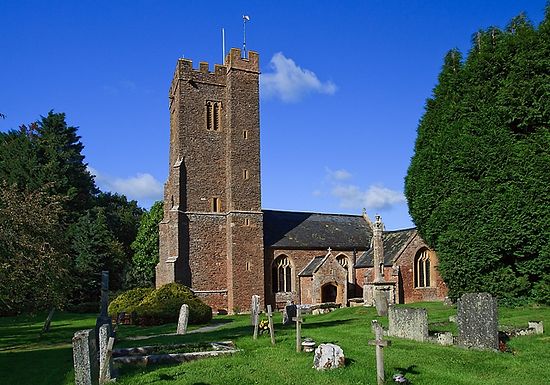 St. Edward's Church in Goathurst, Somerset
St. Edward's Church in Goathurst, Somerset
Anglican parish churches dedicated to St. Edward can be found in the large village of Castle Donington in Leicestershire, in the port town of Plymouth in Devon, in the village of Shaugh Prior in Devon, in Goathurst in Somerset, in Barrow Gurney in Somerset (it has the double dedication of Our Lady and St. Edward and is situated not far from the medieval Barrow Gurney convent), in Evenlode in Gloucestershire, in the city of Cambridge (this thirteenth century church stands on the site of the original early English church; the present church is known for the fact that in 1525 it was the first in England to preach the ideas of Protestantism) and in other places.
St. Edward the Martyr is the patron-saint of the Antiochian Orthodox parish in Athelhampton, Dorset, as well as the Russian Orthodox (Diocese of Sourozh) community in Shapwick, near Wimborne in Dorset. The picturesque Cotswold town of Stow-on-the-Wold in Gloucestershire was originally called Stow St. Edward or Edwardstow, probably after this saint. St. Edward is venerated all over England and in many other countries, and, notably, he is one of the best-known English saints in Russia. St. Edward the Martyr is not to be confused with Edward the Confessor, the half-Norman King of England who ruled from 1042 to 1066, who is venerated only in Roman Catholicism, and whose remains are enshrined in Westminster Abbey in London.
Holy Passion-Bearer King Edward, pray to God for us!

